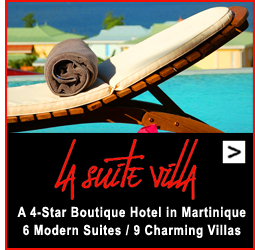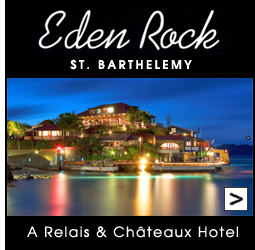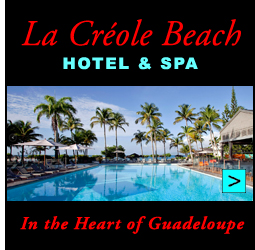Guadeloupe - Description, Beaches, History
Shaped like a butterfly, Guadeloupe is actually two large islands connected by a bridge over the Rivière Salée.
The eastern side, Grande Terre, includes soft rolling terrain, cane fields, sensational white sand beaches, resort areas and Guadeloupe's largest city, Pointe-a-Pitre.
The eastern side, Grande Terre, includes soft rolling terrain, cane fields, sensational white sand beaches, resort areas and Guadeloupe's largest city, Pointe-a-Pitre.
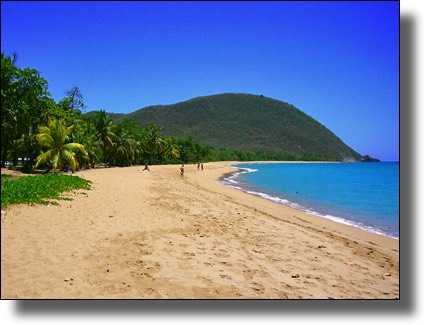
The western island, Basse-Terre offers a dramatic rain forest, towering waterfalls, magnificent beaches, world-class diving, a dormant volcano and Guadeloupe's capitol city, also called Basse-Terre.
Although it is a French island, Guadeloupe’s people, personality and culture are the result of a harmonious blending of European, African and East Indian origins. A French sense of style and joie de vivre permeate the islands. The locals seem delightfully colorblind when it comes to skin color. In Guadeloupe, what counts most is the quality of your heart, not the color of your skin.
The excellent highway system make it easy to navigate Guadeloupe by car and hiking trails network the lush rain forest. On both halves of the butterfly, friendly West Indian hospitality and delicious cuisine enhance the natural wonders of Guadeloupe.
In its official status, the Départment of Guadeloupe is an archipelago of French possessions. This collection includes the islands of Les Saintes, La Désirade, Marie-Galante and Guadeloupe itself. In practice however, the name Guadeloupe simply refers to the butterfly-shaped destination.
Guadeloupe is located 3075 km (1845 mi) from New York, 7267 km (4360 mi) from Paris, 3563 km (2138 mi) from Montreal, 502 km (310 mi) from San Juan and 208 km (125 mi) from St. Barthélemy. The western wing, Basse-Terre, is 811 sq. km (312 sq. mi) and the eastern wing, Grande-Terre, is 567 sq. km (218 sq. mi).
The population of Guadeloupe proper is approximately 415,000. The figure for all of Guadeloupe, including the offshore islands of Les Saintes, Marie-Galante and Désirade, is approximately 449,000.
BEACHES
Guadeloupe is justifiably proud of its spectacular beaches, many of which are well sheltered and ideal for swimming. The natural beaches, all beautiful to behold, range from the long white stretches of sand on Grande-Terre to the darker sands of Basse-Terre. Guadeloupe standouts include those at Ste. Anne, St. François and Le Moule on Grande-Terre, as well as the golden sands of Grande Anse at Deshaies on Basse-Terre. Public beaches are free, though some may charge for parking. Unlike hotel beaches, they have few facilities. Hotels generally welcome non-guests but charge for changing facilities, beach chairs and towels.
The only clothing-optional Guadeloupe beach is a small cove at Plage Tarare near Pointe-des-Châteaux. As is true with clothing-optional beaches everywhere, women should not arrive alone. Topless sunning and swimming in Guadeloupe is more common at hotels and in resort areas than on village beaches. Take your cue from how the locals are dressed.
A BRIEF HISTORY
Christopher Columbus landed on Guadeloupe on November 4, 1493. Though originally called Karukéra (Island of Beautiful Waters) by the Carib Indians, Columbus named the island after the famous sanctuary of Santa Maria de Guadalupe de Estremadura. Lacking gold and silver, the island was not of great interest to the Europeans until the17th century. For a brief period the Spanish had tried to settle Guadeloupe but were stopped by the ferocious Carib Indians. Then around 1635, the French began to colonize the island. With the institutionalization of slavery in 1644, agricultural production increased dramatically, and the trade of spices, sugar, tobacco and rum prospered between France, Africa and the Antilles.
The spectacular Memorial ACTe, a beautiful historical museum located in Pointe-a-Pitre, which offers exhibits on the Caribbean slave trade and the island’s indigenous people, opened in 2015.
Guadeloupe was officially annexed by the King of France in 1674. As the island prospered, it became the scene of great battles between the French and the British, who occupied it from 1759 to 1763. That year it was restored to France in exchange for all French rights to Canada. But the tug-of-war continued on and off until 1815, when the Treaty of Paris designated Guadeloupe as French. In 1848, thanks to the efforts of Victor Schoelcher, slavery was abolished. Guadeloupe was represented for the first time in the French Parliament in 1871. It became a French Départment on March 19, 1946.
Although it is a French island, Guadeloupe’s people, personality and culture are the result of a harmonious blending of European, African and East Indian origins. A French sense of style and joie de vivre permeate the islands. The locals seem delightfully colorblind when it comes to skin color. In Guadeloupe, what counts most is the quality of your heart, not the color of your skin.
The excellent highway system make it easy to navigate Guadeloupe by car and hiking trails network the lush rain forest. On both halves of the butterfly, friendly West Indian hospitality and delicious cuisine enhance the natural wonders of Guadeloupe.
In its official status, the Départment of Guadeloupe is an archipelago of French possessions. This collection includes the islands of Les Saintes, La Désirade, Marie-Galante and Guadeloupe itself. In practice however, the name Guadeloupe simply refers to the butterfly-shaped destination.
Guadeloupe is located 3075 km (1845 mi) from New York, 7267 km (4360 mi) from Paris, 3563 km (2138 mi) from Montreal, 502 km (310 mi) from San Juan and 208 km (125 mi) from St. Barthélemy. The western wing, Basse-Terre, is 811 sq. km (312 sq. mi) and the eastern wing, Grande-Terre, is 567 sq. km (218 sq. mi).
The population of Guadeloupe proper is approximately 415,000. The figure for all of Guadeloupe, including the offshore islands of Les Saintes, Marie-Galante and Désirade, is approximately 449,000.
BEACHES
Guadeloupe is justifiably proud of its spectacular beaches, many of which are well sheltered and ideal for swimming. The natural beaches, all beautiful to behold, range from the long white stretches of sand on Grande-Terre to the darker sands of Basse-Terre. Guadeloupe standouts include those at Ste. Anne, St. François and Le Moule on Grande-Terre, as well as the golden sands of Grande Anse at Deshaies on Basse-Terre. Public beaches are free, though some may charge for parking. Unlike hotel beaches, they have few facilities. Hotels generally welcome non-guests but charge for changing facilities, beach chairs and towels.
The only clothing-optional Guadeloupe beach is a small cove at Plage Tarare near Pointe-des-Châteaux. As is true with clothing-optional beaches everywhere, women should not arrive alone. Topless sunning and swimming in Guadeloupe is more common at hotels and in resort areas than on village beaches. Take your cue from how the locals are dressed.
A BRIEF HISTORY
Christopher Columbus landed on Guadeloupe on November 4, 1493. Though originally called Karukéra (Island of Beautiful Waters) by the Carib Indians, Columbus named the island after the famous sanctuary of Santa Maria de Guadalupe de Estremadura. Lacking gold and silver, the island was not of great interest to the Europeans until the17th century. For a brief period the Spanish had tried to settle Guadeloupe but were stopped by the ferocious Carib Indians. Then around 1635, the French began to colonize the island. With the institutionalization of slavery in 1644, agricultural production increased dramatically, and the trade of spices, sugar, tobacco and rum prospered between France, Africa and the Antilles.
The spectacular Memorial ACTe, a beautiful historical museum located in Pointe-a-Pitre, which offers exhibits on the Caribbean slave trade and the island’s indigenous people, opened in 2015.
Guadeloupe was officially annexed by the King of France in 1674. As the island prospered, it became the scene of great battles between the French and the British, who occupied it from 1759 to 1763. That year it was restored to France in exchange for all French rights to Canada. But the tug-of-war continued on and off until 1815, when the Treaty of Paris designated Guadeloupe as French. In 1848, thanks to the efforts of Victor Schoelcher, slavery was abolished. Guadeloupe was represented for the first time in the French Parliament in 1871. It became a French Départment on March 19, 1946.
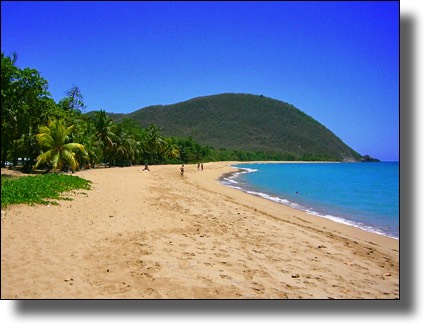
The eastern side, Grande Terre, includes soft rolling terrain, cane fields, sensational white sand beaches, resort areas and Guadeloupe's largest city, Pointe-a-Pitre.
The western island, Basse-Terre offers a dramatic rain forest, towering waterfalls, magnificent beaches, world-class diving, a dormant volcano and Guadeloupe's capitol city, also called Basse-Terre.
Although it is a French island, Guadeloupe’s people, personality and culture are the result of a harmonious blending of European, African and East Indian origins. A French sense of style and joie de vivre permeate the islands. The locals seem delightfully colorblind when it comes to skin color. In Guadeloupe, what counts most is the quality of your heart, not the color of your skin.
The excellent highway system make it easy to navigate Guadeloupe by car and hiking trails network the lush rain forest. On both halves of the butterfly, friendly West Indian hospitality and delicious cuisine enhance the natural wonders of Guadeloupe.
In its official status, the Départment of Guadeloupe is an archipelago of French possessions. This collection includes the islands of Les Saintes, La Désirade, Marie-Galante and Guadeloupe itself. In practice however, the name Guadeloupe simply refers to the butterfly-shaped destination.
Guadeloupe is located 3075 km (1845 mi) from New York, 7267 km (4360 mi) from Paris, 3563 km (2138 mi) from Montreal, 502 km (310 mi) from San Juan and 208 km (125 mi) from St. Barthélemy. The western wing, Basse-Terre, is 811 sq. km (312 sq. mi) and the eastern wing, Grande-Terre, is 567 sq. km (218 sq. mi).
The population of Guadeloupe proper is approximately 415,000. The figure for all of Guadeloupe, including the offshore islands of Les Saintes, Marie-Galante and Désirade, is approximately 449,000.
BEACHES
Guadeloupe is justifiably proud of its spectacular beaches, many of which are well sheltered and ideal for swimming. The natural beaches, all beautiful to behold, range from the long white stretches of sand on Grande-Terre to the darker sands of Basse-Terre. Guadeloupe standouts include those at Ste. Anne, St. François and Le Moule on Grande-Terre, as well as the golden sands of Grande Anse at Deshaies on Basse-Terre. Public beaches are free, though some may charge for parking. Unlike hotel beaches, they have few facilities. Hotels generally welcome non-guests but charge for changing facilities, beach chairs and towels.
The only clothing-optional Guadeloupe beach is a small cove at Plage Tarare near Pointe-des-Châteaux. As is true with clothing-optional beaches everywhere, women should not arrive alone. Topless sunning and swimming in Guadeloupe is more common at hotels and in resort areas than on village beaches. Take your cue from how the locals are dressed.
A BRIEF HISTORY
Christopher Columbus landed on Guadeloupe on November 4, 1493. Though originally called Karukéra (Island of Beautiful Waters) by the Carib Indians, Columbus named the island after the famous sanctuary of Santa Maria de Guadalupe de Estremadura. Lacking gold and silver, the island was not of great interest to the Europeans until the17th century. For a brief period the Spanish had tried to settle Guadeloupe but were stopped by the ferocious Carib Indians. Then around 1635, the French began to colonize the island. With the institutionalization of slavery in 1644, agricultural production increased dramatically, and the trade of spices, sugar, tobacco and rum prospered between France, Africa and the Antilles.
The spectacular Memorial ACTe, a beautiful historical museum located in Pointe-a-Pitre, which offers exhibits on the Caribbean slave trade and the island’s indigenous people, opened in 2015.
Guadeloupe was officially annexed by the King of France in 1674. As the island prospered, it became the scene of great battles between the French and the British, who occupied it from 1759 to 1763. That year it was restored to France in exchange for all French rights to Canada. But the tug-of-war continued on and off until 1815, when the Treaty of Paris designated Guadeloupe as French. In 1848, thanks to the efforts of Victor Schoelcher, slavery was abolished. Guadeloupe was represented for the first time in the French Parliament in 1871. It became a French Départment on March 19, 1946.
________________________________________
French Caribbean International has been the premier guide to the French West Indies since 1994. We provide a wealth of helpful travel information for visitors to the Caribbean islands of St. Barthélemy (St. Barts, St. Barth, St. Barths), St. Martin / St. Maarten, Martinique, Guadeloupe, Les Saintes and Marie-Galante.




